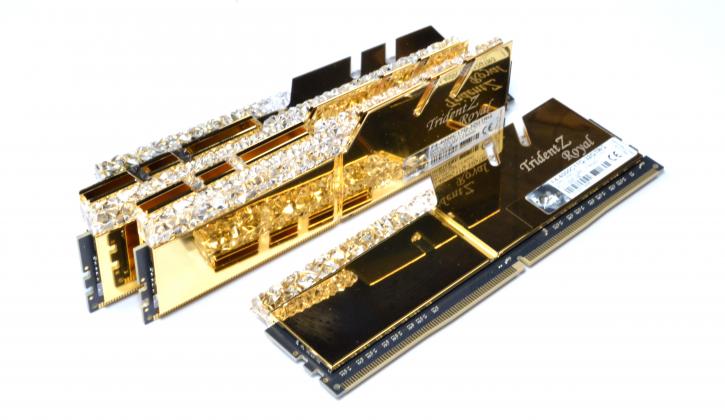Introduction
G.Skill TridentZ Royal DDR4 4000 MHz CL17 32 GB (4x 8 GB)
Today, we are looking at G.Skill TridentZ Royal 4000 MHz CL17 memory in a 32 GB set consisting of four 8 GB modules. At the end of 2018, we had an opportunity to check a lower-clocked kit from that series (3200 MHz), but the capacity was 2 x 8 GB back then. G.Skill’s TridentZ Royal Series is offered at speeds ranging from 2666 MHz up to 4800 MHz, with XMP 2.0 support. You have to keep in mind that you’d need a suitable CPU and motherboard to take advantage of the 4000+ MHz variant, as it’s not possible to achieve that frequency “automatically” with just any system (in the case of the Intel platform, as for AMD Ryzen it’s rather the Infinity Fabric divider that should be preferably set to 1:1 that confines you). The looks feature a full-length crystalline light bar upon a polished heat spreader in golden or silver color, with awesome 8-zone RGB lighting.
You can use Asus Aura Sync, Gigabyte RGB Fusion, MSI Mystic Light, or ASRock Polychrome Sync to control it. The provided kit of four 8 GB modules with a frequency of 4000 MHz and CL17 sounds really good. It’s optimal for Intel-based systems, but as we suppose it’s based on Samsung B-Die chips, after some tweaking, it should be possible to achieve great results in the range of 3600-3733 MHz on Ryzen systems as well. The G.Skill TridentZ Royal is relatively low-profile (44 mm in height), so it shouldn’t cause problems with most CPU coolers on the market. 4000 MHz is not the highest frequency available from TridentZ Royal. There are also 4800 MHz kits with CL18-22-22-42 at 1.50V. That’s total overkill for almost any user, and to be able to achieve it, you’d need a top-tier motherboard and a good CPU. We will check how this kit performs on two platforms: a Z390-based motherboard/CPU and an X470 one. We are traditionally still going to try to squeeze something more out of it, so maybe the standard 4000 MHz is not the last word here. If you prefer, you can always stay on the safe side and stick to the advertised frequency and latencies using XMP. Naturally, these kits are optimized for both AMD and Intel systems (which will be tested in this review). A limited lifetime warranty backs the TridentZ Royal series. Next page, please.


